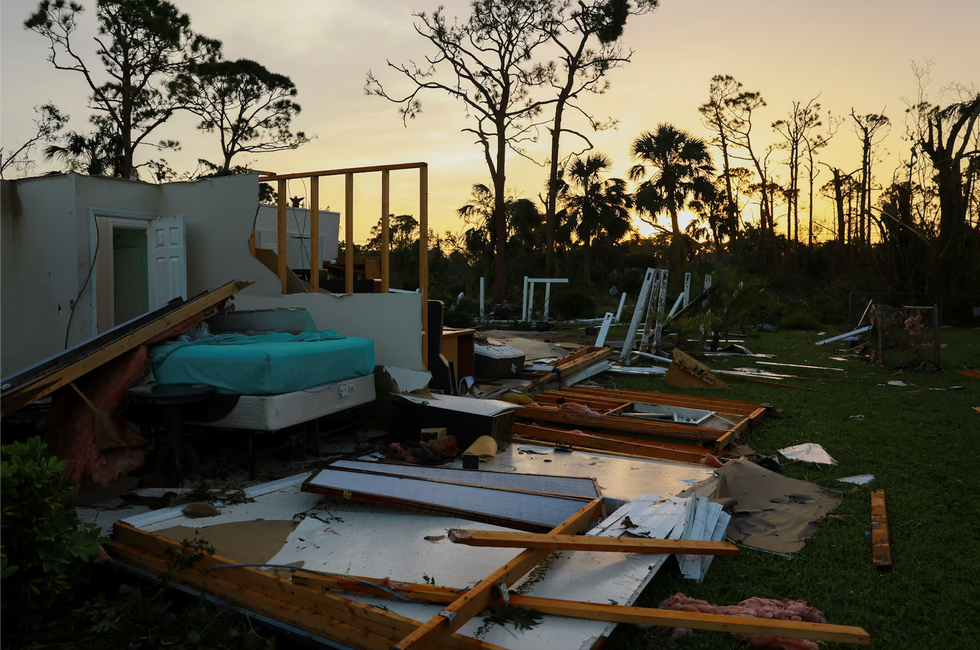What makes Florida the 'hurricane hotspot' of the US
Beryl, Debby, Francine, Helene, and Milton are five hurricanes that hit the U.S. coastal state this hurricane season

Laiba Zai
Producer, News Desk
Laiba is a multi-media journalist, passionate about American politics and digital rights. She has a degree in social sciences from IBA, Karachi.
Expert says Florida susceptible to hurricanes because of its location 300 miles above the equator, where the ‘Coriolis effect’ kicks in
A 2024 forecast report from Colorado State University's Department of Atmospheric Science predicts 12 hurricanes to make landfall in the U.S. this season
Beryl, Debby, Francine, Helene. These aren’t the names of pop girl band members. Instead, they’re four out of the five hurricanes that hit the U.S. coastal state of Florida, this hurricane season. Each hurricane brought its own set of devastation and destruction, with Helene claiming at least 228 lives, according to USA Today.
Hurricane Milton was the fifth hurricane to make landfall in the Sunshine State, causing severe flooding and blackouts.
However, this isn't the first time Florida has faced a consecutive string of hurricanes in the same season, which runs from June to November each year. In 2004, hurricanes Charley, Frances, Ivan, and Jeanne all took turns swiping at the state, each one different but delivering the same message: life in hurricane territory is no joke. And just when Florida thought it could catch a break, 2005 rolled in with Dennis, Katrina, Rita, and Wilma, leaving a trail of destruction from the mainland to the Keys.
Nukta spoke to U.S.-based consulting hydrologist and geologist Dr Asim Yousafzai to find out what makes this U.S. coastal state so prone to recurring hurricanes.
It’s all about geography
“If you look at the map of the U.S., the state of Florida is like a finger pointing in the southern direction,” stated Dr. Asim. The state lies between the Gulf of Mexico and the Atlantic Ocean—both warm, tropical waters, perfect for brewing hurricanes.

“Within about 300 miles of the equator, a hurricane cannot form, but Florida and Florida Keys are much above 300 miles above the equator. This is where the 'Coriolis effect'' kicks in,” explained Dr. Asim.
The Coriolis effect refers to the deflection of moving objects - for objects to move at a curve as opposed to a straight line - due to Earth's rotation. This effect influences large-scale weather patterns. Since Earth rotates faster at the equator (about 1,600 km/h) than at the poles, this difference in speed causes the deflection.

“The spinning effect only occurs when you are further away from the equator. This is why Florida, and especially the Florida Keys, is being hit by so many storms every year. Because it is in that perfect area where storms can form and sustain,” stated Dr. Asim.
Storm-proof Europe?
While the U.S. coast faces hurricanes every year, that's not the case as you move eastward from North America. Even with Southern Europe’s warm Mediterranean waters, its coastal countries are rarely hit by intense hurricanes.
The reason for this lies in the misconception that storms are initially formed in the Atlantic.
“The winds pick up these very small dust particles from the Sahara desert. So storms are actually starting from the African continent,” explained Dr. Asim.
These winds, according to the hydrologist, move westward due to Earth's gyres, and large systems of rotating ocean currents, and create a counterclockwise motion in the northern hemisphere, which is key for hurricane development.
As a result, most storms form on the western side of the Atlantic, impacting the U.S., while Europe remains largely unaffected.
'The weirdest storm’
While geography plays a major part in where hurricanes make landfall, climate change is a huge contributor to their growing intensity.
“There are more greenhouse gasses which are being emitted into the atmosphere due to human-induced climate change. The developed world, along with China, is largely the culprit for this issue, having emitted more greenhouse gasses than all other countries combined,” stated Dr. Asim.
The emission of gases creates a thickening envelope around the atmosphere. This traps heat and increases humidity. As oceans warm, they release more moisture into the atmosphere, which eventually returns to Earth as intense rainfall. This process, part of the hydrologic cycle, is now supercharged by climate change, leading to more frequent and severe storms.

Pointing to the heavy rains that followed the landfall of hurricane Helene and Milton, the hydrologist, categorized Milton as ‘the weirdest storm’.
“It had more than 100 tornadoes associated with it, which we have never seen in the past. Storm surges, wind gusts, flooding, tornadoes – all four different categories of hazards combined in this one storm, made Milton extremely damaging,” the hydrologist stated.
Reuters
An aerial view shows the damaged Tropicana Field, home of the Tampa Bay Rays, in the aftermath of Hurricane Milton, in St. Petersburg, Florida October 10.




Future predictions and misinformation
A 2024 forecast report from Colorado State University's Department of Atmospheric Science predicts that 12 hurricanes are expected to make landfall in the U.S. this season.
“Scientists working in NASA and NOAA (National Oceanic and Atmospheric Administration) have already predicted that this is going to be a worse year, and that's what we see precisely,” noted Dr. Asim.
In terms of future storm predictions, the hydrologist highlighted the likelihood of two to three more storms to form in the Atlantic this season.
“While they may not all reach Florida, there’s a strong chance that at least one major storm will hit the state again,” he stated.
Dr. Asim further criticized the spread of misinformation by U.S. political leaders.
“Unfortunately, there is a lot of disinformation and misinformation spread by political leaders about these storms, which is not helping anybody,” he indicated.
Republicans, including Congresswoman Marjorie Taylor Greene, have stoked controversy over weather modification related to hurricanes, accusing Democrats of artificially manipulating the weather to target Republican strongholds.

“Let the scientific community focus on making accurate predictions so that individuals have a fair chance to evacuate if they choose to, rather than providing them with information about uncontrollable natural phenomena,” advised Dr. Asim.











Comments
See what people are discussing